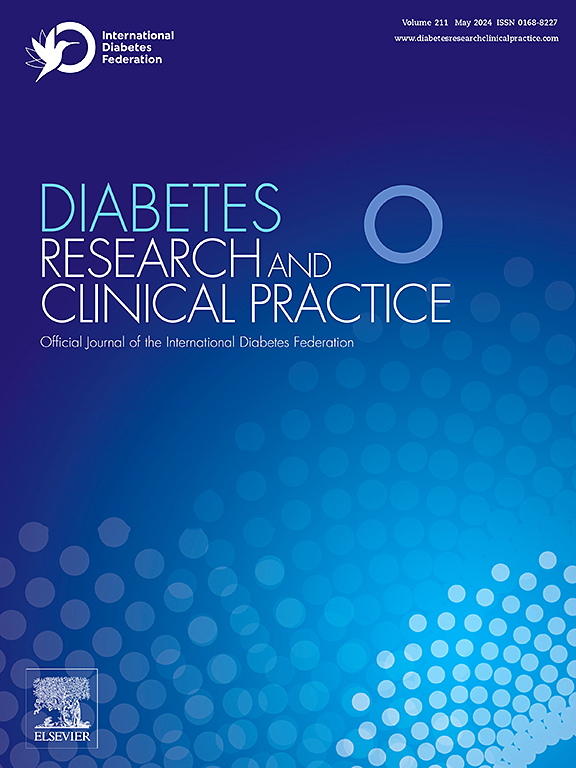初级保健人群中糖尿病微血管并发症随访筛查的不依从性:预测因素、相关障碍和促进因素
IF 6.1
3区 医学
Q1 ENDOCRINOLOGY & METABOLISM
引用次数: 0
摘要
目的:我们确定了2型糖尿病初级保健患者糖尿病视网膜病变(DR)、肾病(DN)和足部并发症(DFC)筛查年度随访筛查不遵守的比率、预测因素和障碍/促进因素。方法本前瞻性混合临床研究纳入934例接受DR/DN/DFC筛查的患者(平均±SD年龄60.4±9.4岁,46.9%为女性)(N = 2012次预约)。Logistic回归分析确定了不遵守随访筛查(在±4个月内未能参加年度随访筛查)的基线预测因素。对36/24名非依从性/依从性患者和9名卫生保健专业人员(HCPs)进行了筛查依从性障碍/促进因素的定性访谈。结果DR、DFC和DN随访筛查不依循率分别为27.6% (n = 186)、29.8% (n = 225)和12.7% (n = 74)。预测因子包括较高的总胆固醇(DR);自评糖尿病控制(DN)差;糖尿病支持(DFC和DN)满意度较高。较好的自我效能感具有保护作用(DFC)。不良的hcp患者沟通和漫长的等待时间是患者报告的依从性障碍,而了解糖尿病并发症筛查的益处是一个促进因素。时间限制阻碍了卫生保健提供者对患者加强筛查的重要性。结论在新加坡,糖尿病微血管并发症的非依从性随访筛查是次优的,并受到多方面的预测因素和障碍的驱动。需要有针对性的干预措施来提高随访筛查的依从性。本文章由计算机程序翻译,如有差异,请以英文原文为准。
Non-adherence to diabetes microvascular complications follow-up screening in the primary care population: Predictors, associated barriers, and facilitators
Aims
We determined the rates, predictors, and barriers/facilitators of non-adherence to annual follow-up screenings for Diabetic Retinopathy (DR), nephropathy (DN) and foot complications (DFC) screening in primary care patients with type 2 diabetes.
Methods
This prospective, mixed-method, clinical study, included 934 patients (mean ± SD age 60.4 ± 9.4 years, 46.9 % women) who underwent DR/DN/DFC screenings (N = 2012 appointments). Logistic regression analysis determined the baseline predictors of non-adherence to follow-up screening (failure to attend annual follow-up screening within ± 4 months). Qualitative interviews on barriers/facilitators of screening adherence were conducted with 36/24 non-adherent/adherent patients and 9 healthcare professionals (HCPs).
Results
Non-adherence rates to DR, DFC and DN follow-up screening were 27.6 % (n = 186), 29.8 % (n = 225) and 12.7 % (n = 74), respectively. Predictors included higher total cholesterol (DR); poor self-rated Diabetes Control (DN); and higher satisfaction with diabetes support (DFC and DN). Better self-efficacy was protective (DFC). Poor HCP-patient communication and long waiting times were patient-reported barriers to adherence, while knowledge about benefits of diabetes complications screening was a facilitator. Time constraints prevented HCPs from reinforcing the importance of screening to patients.
Conclusions
Non-adherence to diabetic microvascular complications follow-up screening was suboptimal in Singapore and driven by multi-faceted predictors and barriers. Targeted interventions are needed to improve follow-up screening adherence.
求助全文
通过发布文献求助,成功后即可免费获取论文全文。
去求助
来源期刊

Diabetes research and clinical practice
医学-内分泌学与代谢
CiteScore
10.30
自引率
3.90%
发文量
862
审稿时长
32 days
期刊介绍:
Diabetes Research and Clinical Practice is an international journal for health-care providers and clinically oriented researchers that publishes high-quality original research articles and expert reviews in diabetes and related areas. The role of the journal is to provide a venue for dissemination of knowledge and discussion of topics related to diabetes clinical research and patient care. Topics of focus include translational science, genetics, immunology, nutrition, psychosocial research, epidemiology, prevention, socio-economic research, complications, new treatments, technologies and therapy.
 求助内容:
求助内容: 应助结果提醒方式:
应助结果提醒方式:


